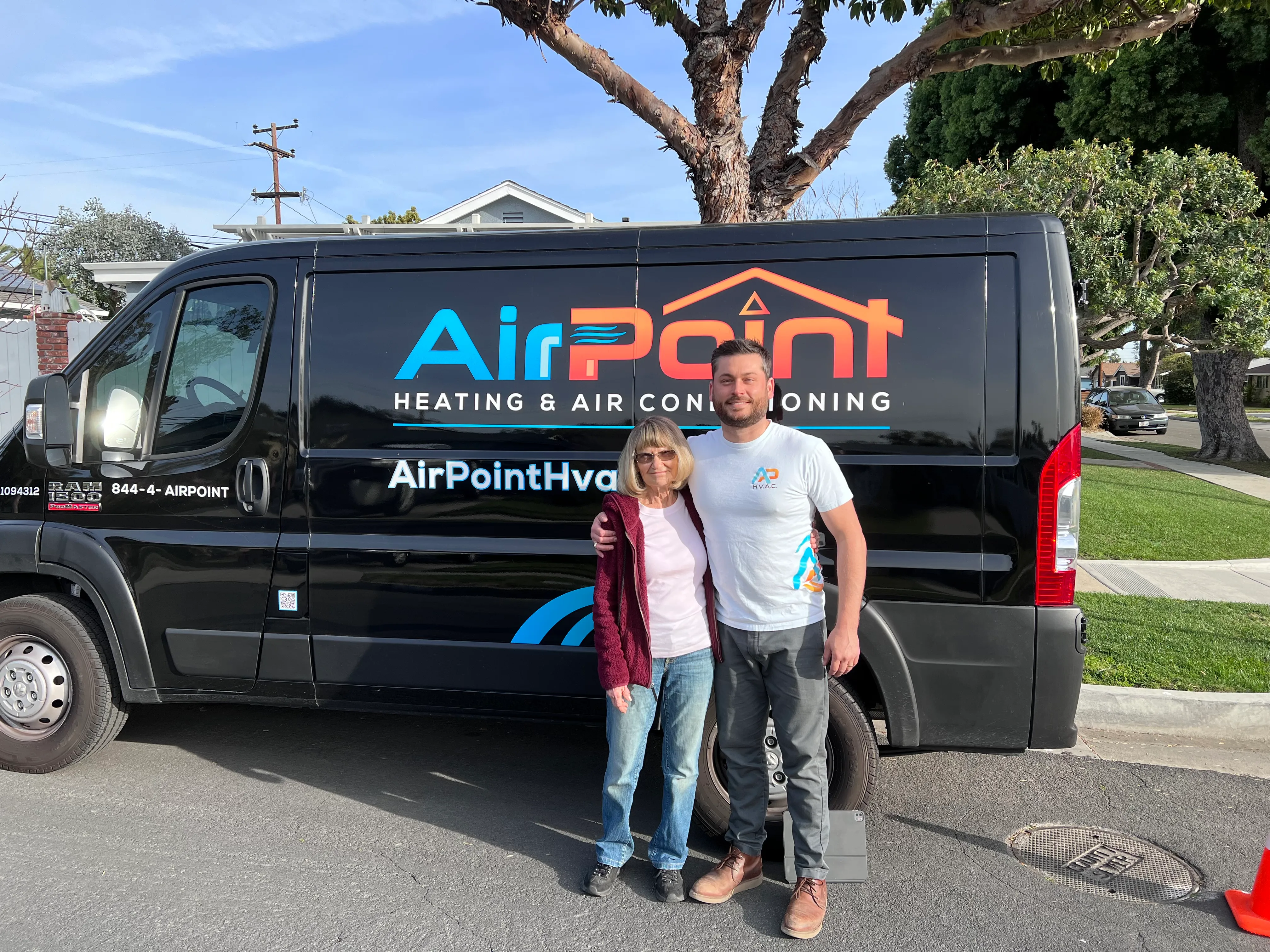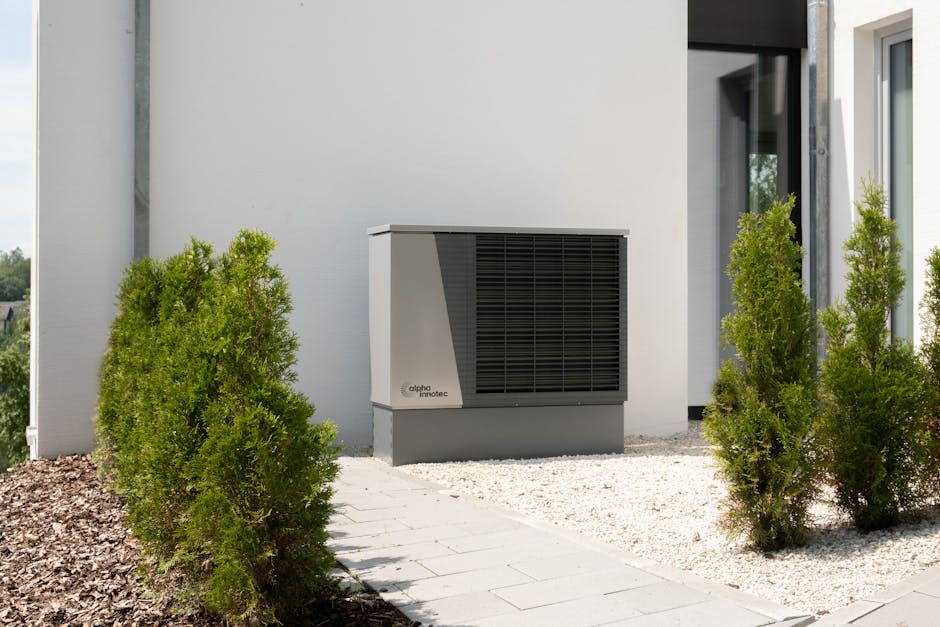
Why Energy Savings Heat Pump Systems Are Changing Home Comfort
Energy savings heat pump systems are revolutionizing how homeowners heat and cool their homes while dramatically reducing utility bills. These innovative machines can slash your electricity use for heating by up to 75% compared to traditional electric resistance heating like furnaces and baseboard heaters.
Quick Answer: How Heat Pumps Save Energy
- Heat Transfer, Not Generation: Move existing heat rather than creating it from scratch
- 3x Efficiency: Deliver up to 3 times more heat energy than the electricity they consume
- Dual Functionality: One system handles both heating and cooling year-round
- Lower Bills: Can save up to 50% on heating costs when switching from electric heating
- Environmental Impact: Reduce carbon emissions by up to 10 tonnes per year
Let's be real: almost half of your typical $1,900 annual energy bill goes to heating and cooling your home. That's where heat pumps become game-changers. Unlike traditional systems that burn fuel or use electric resistance, heat pumps work like an efficient refrigerator in reverse - extracting heat from outdoor air (even in cold weather) and transferring it inside.
The beauty lies in the physics. Because they move heat instead of generating it, heat pumps operate with remarkable efficiency. At moderate temperatures, a quality heat pump can achieve a Coefficient of Performance (COP) between 2.0 and 5.4, meaning it produces 2 to 5.4 units of heat for every unit of electricity consumed.
Modern cold climate heat pumps have solved the old problem of poor performance in freezing weather. Today's models work effectively down to -30°C, making them viable for virtually any climate while maintaining impressive energy savings year-round.
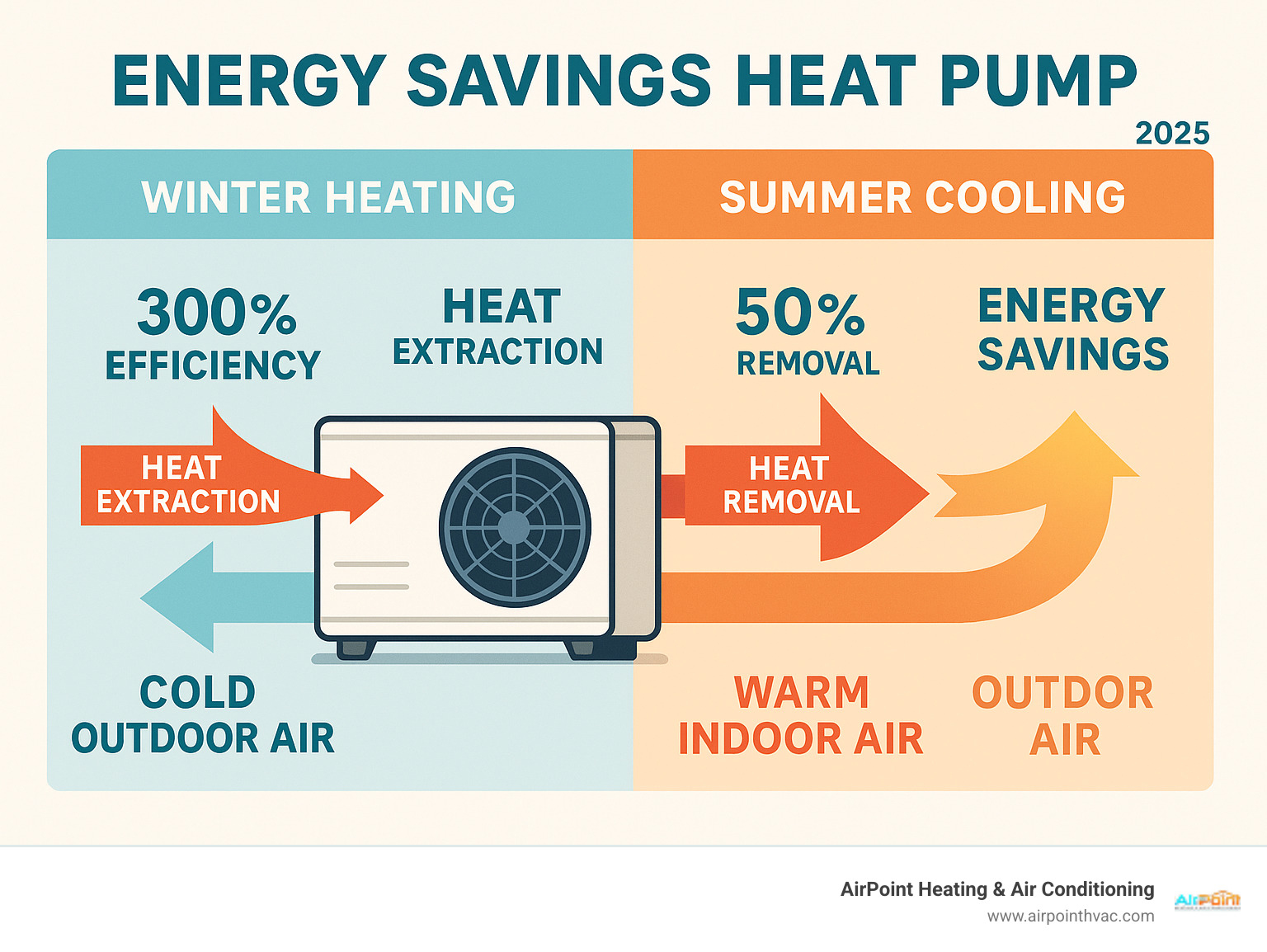
What is a Heat Pump and How Does It Work?
At its heart, a heat pump is an electrically driven device that simply moves heat from one place to another. Think of it like your refrigerator, but on a much larger scale, and with the ability to reverse its function. Instead of creating heat by burning fossil fuels or using electric resistance, heat pumps transfer existing thermal energy. This fundamental difference is why they are so incredibly efficient.
In heating mode, a heat pump extracts latent heat from a low-temperature source, such as the outdoor air or the ground, and uses electricity to increase its temperature before delivering it to a higher-temperature place, like the inside of your home. Even on a chilly winter day, there's a surprising amount of heat energy in the outdoor air that a heat pump can capture and concentrate. Conversely, in cooling mode, the process reverses: the heat pump absorbs heat from the indoor air and releases it outdoors, effectively cooling your living space. This dual functionality means one system can provide comfortable temperatures year-round.
Beyond just heating and cooling, heat pumps also offer excellent dehumidification during the warmer months. As they pull heat and moisture from your indoor air to transfer it outside, they naturally reduce humidity, making your home feel cooler and more comfortable without needing to set the thermostat as low. This contributes to overall comfort and can even improve your indoor air quality by managing moisture levels. For more ways to improve the air you breathe, explore our expertise in Indoor Air Quality.
The Core Components
To understand how this magic happens, let's look at the main components that make up a heat pump's closed-loop system:
- Evaporator Coil: This coil absorbs heat. In heating mode, it's located outside, absorbing heat from the ambient air or ground. In cooling mode, it's inside, absorbing heat from your home's air.
- Condenser Coil: This coil releases heat. In heating mode, it's inside, releasing heat into your home. In cooling mode, it's outside, releasing heat into the outdoor environment.
- Compressor: Often called the "heart" of the system, the compressor is an electric pump that pressurizes the refrigerant, increasing its temperature and allowing it to move heat efficiently between the coils. Just like a bike pump heats up when you pressurize the air, the refrigerant gets hotter under compression.
- Reversing Valve: This clever component is what allows the heat pump to switch between heating and cooling modes. It simply changes the direction of the refrigerant flow.
- Expansion Valve (or Metering Device): This valve reduces the pressure and temperature of the liquid refrigerant before it enters the evaporator coil, preparing it to absorb heat again.
Together, these components circulate a refrigerant, a special fluid that can easily change between liquid and gas states, absorbing and releasing heat as it moves through the system.
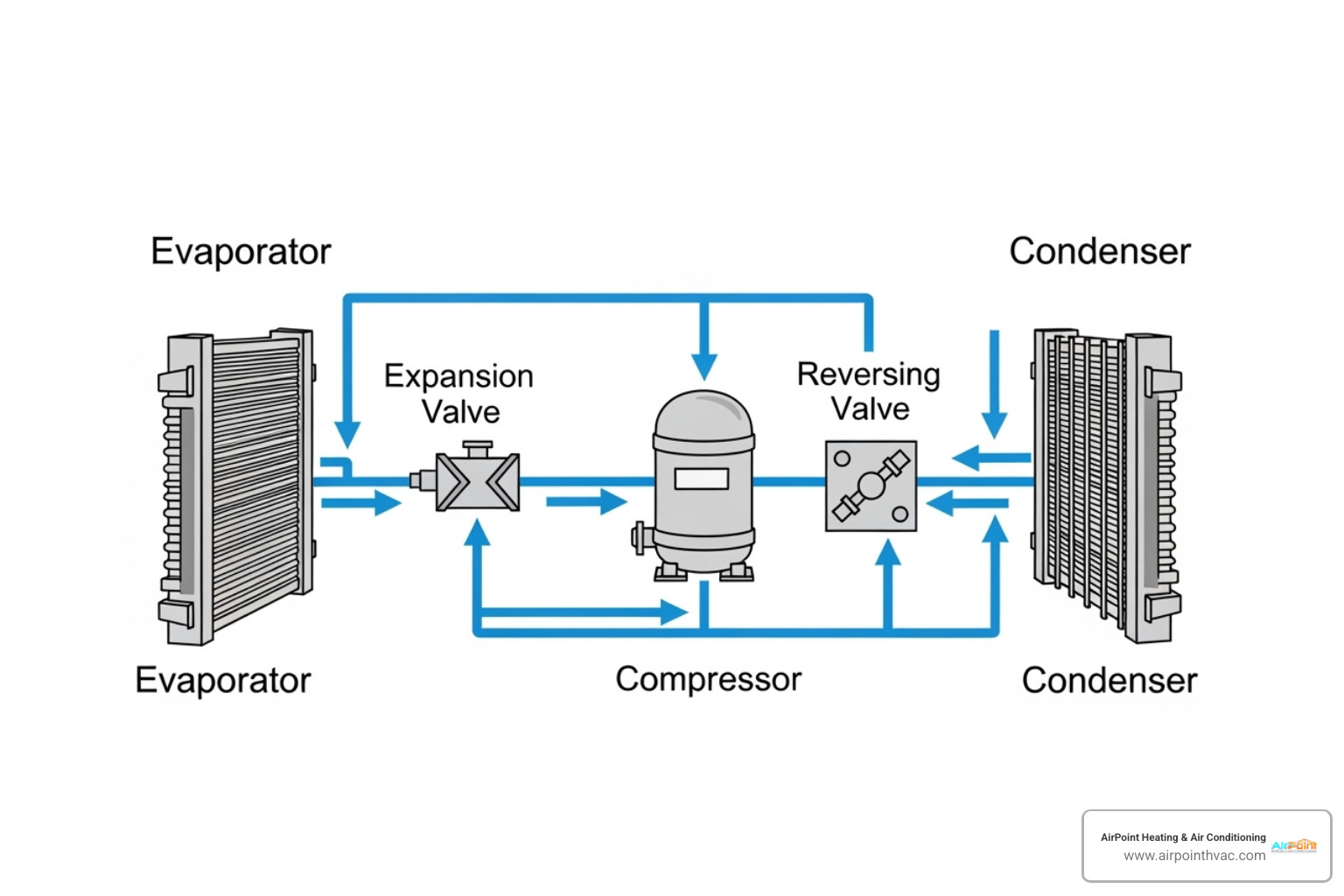
Heat Pumps vs. Traditional Systems
When we compare heat pumps to traditional heating and cooling systems like furnaces, boilers, and conventional air conditioners, the differences in efficiency and functionality are striking.
Here's a quick look at how they stack up:
FeatureHeat PumpFurnace (Gas/Oil)Boiler (Gas/Oil)Traditional ACEfficiencyVery High (COP 2.0-5.4, SEER 14-42)Moderate (AFUE 80-98%)Moderate (AFUE 80-95%)Moderate (SEER 13-21)Fuel SourceElectricity (moves heat)Natural Gas, Propane, Fuel OilNatural Gas, Propane, Fuel OilElectricity (removes heat)FunctionalityHeating & Cooling (all-in-one)Heating onlyHeating only (often with radiant heat)Cooling onlyEnvironmentalLow/Zero On-Site EmissionsHigh On-Site EmissionsHigh On-Site EmissionsLow On-Site EmissionsHeat GenerationTransfers heatGenerates heat through combustionGenerates heat through combustionTransfers heatCost SavingsSignificant, especially vs. electric resistanceCan be high, depends on fuel pricesCan be high, depends on fuel pricesModerate, for cooling only
As you can see, heat pumps offer a distinct advantage by providing both heating and cooling from a single, highly efficient unit. This means you don't need separate systems cluttering your utility space or doubling your maintenance needs.
In terms of pure efficiency, heat pumps are hard to beat. For instance, an air-source heat pump can heat your space up to 2.5 times more efficiently than an oil furnace or boiler, and up to 2 times more efficiently than electric furnaces or baseboards. Even compared to a gas furnace, some heat pumps can be up to 2.5 times more efficient! This translates directly into lower energy consumption and significant savings on your utility bills. When you consider upgrading your heating system, it’s worth exploring all the options. Learn more about our Heating Services.
Maximizing Your Energy Savings with a Heat Pump
The promise of a heat pump is simple: remarkable energy savings. As we've mentioned, switching from an electric furnace or electric baseboard heating to a cold climate air source heat pump could save you up to 50% on the heating portion of your electricity bills. For many households, that could mean an annual savings averaging over $500! Imagine what you could do with that extra money.
This isn't just about reducing your energy consumption; it's about optimizing how your home stays comfortable, leading to lower utility bills and year-round savings.

How a Heat Pump Delivers Remarkable Energy Savings
The core principle behind a heat pump's efficiency is that it moves heat, rather than generating it. Generating heat, whether through burning fossil fuels or using electric resistance, consumes a lot of energy. Moving existing heat, however, requires far less energy. This is why an air-source heat pump can deliver up to three times more heat energy to a home than the electrical energy it consumes. It's like pushing a door open versus building a whole new door every time you want to enter a room – one is clearly more efficient!
This incredible efficiency significantly reduces your reliance on often-expensive fossil fuels, leading to a noticeable drop in your energy bills. Plus, with a heat pump, you get consistent comfort. These systems are designed to maintain a steady indoor temperature, avoiding the drastic temperature swings often associated with traditional furnaces cycling on and off. This constant, gentle heating or cooling not only feels better but also contributes to overall energy savings by preventing the system from having to work harder to recover from large temperature drops or spikes. To dive deeper into the financial benefits, check out our insights on Energy Savings with Heat Pumps.
Understanding Efficiency Ratings for Maximum Energy Savings with a Heat Pump
When you're looking at heat pumps, you'll encounter a few acronyms that tell you a lot about their energy efficiency. Understanding these ratings is key to making an informed decision and ensuring you get the most significant energy savings heat pump has to offer.
- SEER (Seasonal Energy Efficiency Ratio): This rating measures a heat pump's cooling efficiency over an entire cooling season. A higher SEER rating indicates greater cooling efficiency. For example, the minimum SEER in Canada is 14, but market-available products can range from 14 to an impressive 42! For 2025, anything 15.2 and above is considered solid, with 17+ offering quicker payoff through savings.
- HSPF (Heating Seasonal Performance Factor): This rating is similar to SEER but measures the heating efficiency over an entire heating season. A higher HSPF means greater heating efficiency. In Canada (Region V), the minimum HSPF is 7.1, with market products ranging up to 13.2. Look for models with COPs over 1.75 at 5º F, a good indicator for cold climates.
- COP (Coefficient of Performance): COP is a measure of a heat pump's heating output relative to its electricity input at a specific temperature. For example, a COP of 3 means the heat pump produces 3 units of heat for every 1 unit of electricity it consumes. This is typically measured at various outdoor temperatures. At 8°C, COPs for air-source heat pumps typically range from 2.0 to 5.4. Even at –8°C, COPs can range from 1.1 to 3.7, demonstrating their continued efficiency in colder conditions.
- EER (Energy Efficiency Ratio): EER measures cooling efficiency at a specific outdoor temperature (typically 35°C/95°F). It's a snapshot of efficiency under peak load conditions.
When comparing models, always look for units with higher SEER and HSPF ratings. These numbers directly translate to lower electricity consumption and greater savings on your utility bills. Choosing an ENERGY STAR® certified heat pump is a great way to ensure you're getting a high-efficiency model that has been independently certified to save energy, save money, and protect the climate. You can learn more about ENERGY STAR® certified heat pumps and their benefits.
Types of Heat Pumps and Key Considerations
Choosing the right heat pump system for your home is a bit like finding the perfect pair of shoes: it needs to fit your unique needs, your home's layout, and, of course, your local climate. There's no one-size-fits-all solution, but understanding the different types available will help us guide you to the best choice. This choice often hinges on factors like whether your home has existing ductwork or if you're looking for a solution for specific zones. For homes with existing ductwork, proper maintenance and even upgrades to your Ductwork Services can significantly impact heat pump performance.
Air-Source, Ground-Source, and Ductless Systems
Let's break down the main types of heat pumps we work with:
- Air-Source Heat Pumps (ASHPs):
- How they work: These are the most common type and transfer heat between your house and the outside air. In winter, they extract heat from the outdoor air and move it indoors. In summer, they reverse, pulling heat from inside your home and releasing it outside.
- Pros:
- Generally the least expensive to install among heat pump types.
- Can be a "drop-in" replacement for existing central air conditioning systems.
- Provide both heating and cooling.
- Advancements mean they are now effective in much colder climates.
- Cons:
- Efficiency can decrease as outdoor temperatures drop significantly, requiring a supplementary heat source in very cold conditions.
- Requires ductwork for whole-home distribution (unless it's a mini-split).
- Ground-Source (Geothermal) Heat Pumps (GSHPs):
- How they work: These systems leverage the stable underground temperatures (around 54 degrees Fahrenheit) to exchange heat. Underground loops circulate a fluid that absorbs heat from the earth in winter and dissipates heat into the earth in summer.
- Pros:
- Extremely efficient year-round due to consistent ground temperatures, leading to significant energy savings (around 65% compared to electric furnaces).
- Long lifespan for the ground loop (up to 75 years).
- Minimal outdoor equipment, reducing noise and aesthetic impact.
- Can provide hot water using a desuperheater.
- Cons:
- Higher upfront installation costs due to the need for ground excavation or drilling for the loops.
- Installation can be disruptive.
- Requires sufficient outdoor space for loop installation.
- Ductless Mini-Split Heat Pumps:
- How they work: These are a type of air-source heat pump that doesn't require traditional ductwork. They consist of an outdoor unit connected to one or more indoor air-handling units via a small conduit. Each indoor unit can control the temperature in its specific zone.
- Pros:
- Ideal for homes without existing ductwork, additions, or for zoning specific areas.
- Highly efficient for targeted heating and cooling, reducing energy waste in unused areas.
- Flexible installation options (wall-mounted, floor-standing, ceiling cassette).
- Excellent for retrofits, especially in homes with electric baseboard heating.
- Cons:
- Higher upfront cost than traditional window AC units or baseboard heaters.
- Indoor units are visible and require space on walls or ceilings.
- May not provide uniform temperature control across an entire large, open floor plan as effectively as a ducted system.
Cold Climate and Hybrid (Dual-Fuel) Systems
The narrative that heat pumps don't work in cold climates is outdated! Thanks to continuous innovation, cold climate heat pump technology has advanced significantly. These specialized air-source heat pumps are designed with improved compressors and refrigerants that allow them to extract heat from outdoor air even when temperatures dip well below freezing, operating effectively down to -30°C. This makes them perfectly suitable for Canada's diverse climate, including regions that experience extended periods of subfreezing temperatures. If you live in a region where temperatures regularly dip below freezing, we highly recommend looking for a system with an ENERGY STAR Cold Climate label. You can learn more about cold climate heat pumps from ENERGY STAR.
For homeowners who want the best of both worlds – the high efficiency of a heat pump with the reliable backup of a traditional furnace – dual-fuel or hybrid heat pump systems are an excellent solution. These systems combine an electric heat pump with a gas or oil furnace. The heat pump handles the majority of the heating needs during milder temperatures, leveraging its superior efficiency. When temperatures drop below a certain set point (the "balance point," typically around 0°C or -5°C), the system automatically switches to the furnace, which can provide more intense heat in extreme cold. This optimizes energy use, as the heat pump operates when it's most efficient, and the furnace takes over when its fuel source is more cost-effective or necessary for comfort. It's a smart way to maximize energy savings heat pump technology offers while ensuring warmth even on the coldest nights.
Sizing, Installation, and Maintenance
Getting the right energy savings heat pump system isn't just about picking a type; it's also about ensuring it's properly sized, expertly installed, and regularly maintained.
- Proper Sizing: This is perhaps one of the most critical steps. A heat pump that's too small won't adequately heat or cool your home, leading to discomfort and overworking the system. One that's too large will "short cycle," turning on and off too frequently, which wastes energy, causes temperature swings, and puts unnecessary wear and tear on components. We use industry-standard calculations, like Manual J, to determine your home's precise heating and cooling load, ensuring your new heat pump is perfectly sized for optimal performance and efficiency.
- Professional Installation: A heat pump's efficiency and lifespan are highly dependent on professional installation. This involves more than just connecting pipes and wires; it includes ensuring proper duct sealing to minimize unwanted leaks, especially if ducts run through unconditioned spaces like attics or crawl spaces. For new construction, locating ducts and air handlers within the conditioned space further boosts efficiency. Our team provides expert Heat Pump Installation to guarantee your system operates at peak performance from day one.
- Maintenance Requirements: Like any complex appliance, heat pumps require regular care to ensure optimal performance and longevity.
- Filter Cleaning/Replacement: This is something you can easily do yourself. We recommend checking and cleaning or replacing your air filters every 1 to 3 months, or more frequently if you have pets or allergies. A clogged filter restricts airflow, making your heat pump work harder and consume more energy.
- Annual Tune-Ups: Schedule a professional heat pump tune-up once a year. Our technicians will inspect, clean, and adjust components, check refrigerant levels, and identify any potential issues before they become costly problems. This proactive approach ensures your system runs efficiently, maintains its warranty, and extends its life. Learn more about our comprehensive Heat Pump Maintenance services.
- Clear Outdoor Unit: Keep the outdoor unit free from debris, leaves, snow, and ice to ensure proper airflow.
With proper installation and routine maintenance, air-source heat pumps typically have a service life of between 15 and 20 years. Ground-source heat pumps, with their more stable operating conditions, can last even longer, generally 20 to 25 years, with the underground loop system itself lasting an impressive 75 years or more! This long life expectancy means your investment in an energy savings heat pump system will pay dividends for many years to come.
Financial Incentives and Finding a Qualified Contractor
We know that investing in a new heating and cooling system is a significant decision. The good news is that the long-term energy savings heat pumps provide are often bolstered by various financial incentives, grants, and rebates designed to lower your upfront investment. Plus, choosing the right professional for installation and service is paramount to maximizing those savings and ensuring peace of mind.
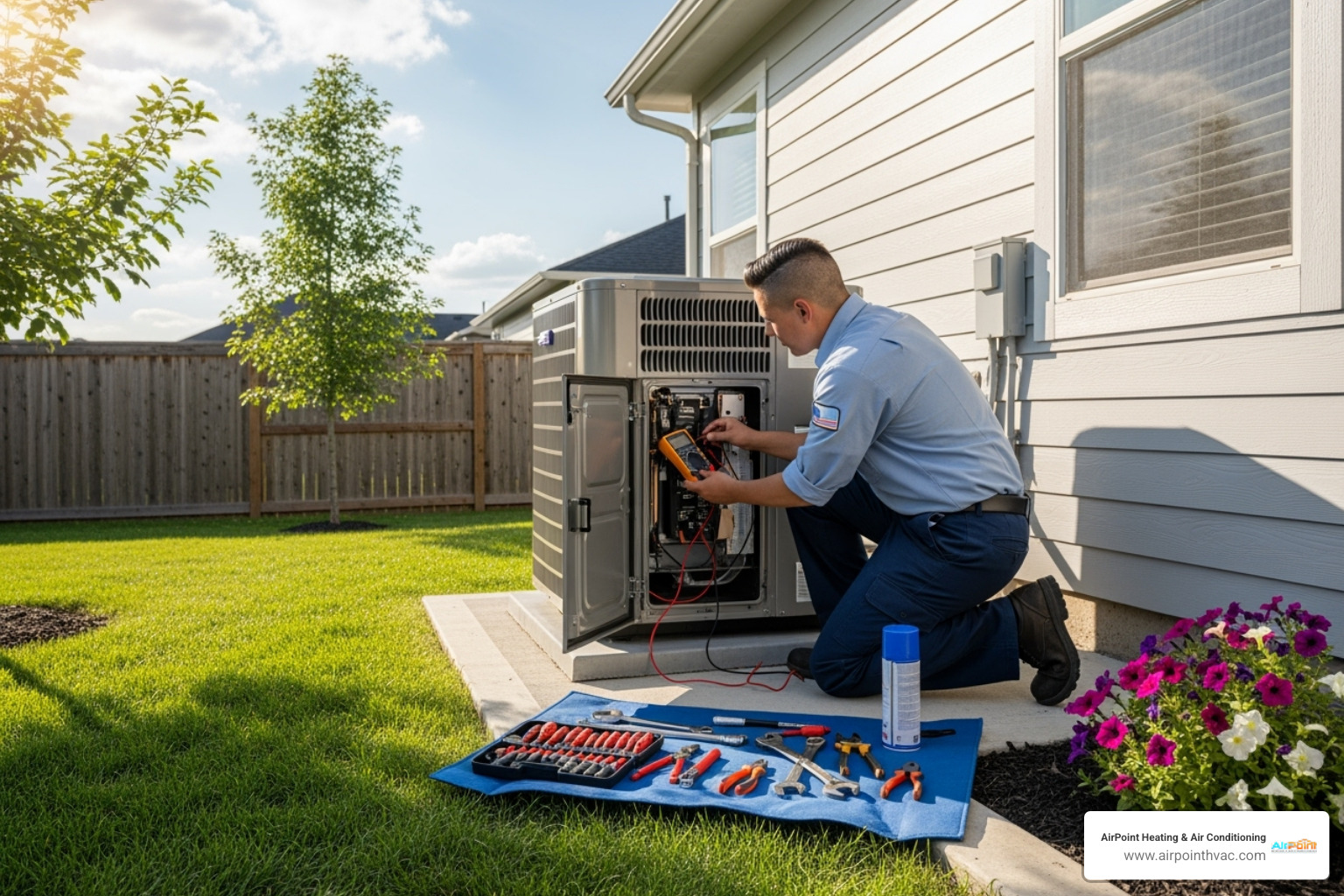
Available Rebates and Grants
Governments and utility providers recognize the environmental and economic benefits of heat pumps, leading to a variety of programs to encourage their adoption:
- Federal Tax Credits: Many homeowners are eligible for federal tax credits for installing high-efficiency heat pumps. For instance, the federal tax credit for ENERGY STAR certified heat pumps can be up to $2,000 for products purchased and installed between January 1, 2023, and December 31, 2032.
- State and Local Incentives: Beyond federal programs, many states, provinces, and municipalities offer their own rebates or grants. For our Canadian friends, the Canada Greener Homes Initiative is a prime example, providing incentives for energy efficiency retrofits, including heat pumps.
- Utility Provider Rebates: Your local electricity or gas company may also offer rebates for installing energy-efficient heat pumps. These incentives can vary widely, so it's always worth checking what's available in your service area.
To easily find out what financial assistance might be available to you, we recommend using the ENERGY STAR Rebate Finder. These incentives can make a substantial difference in the total cost of your installation, making the switch to an energy savings heat pump even more attractive.
Hiring the Right HVAC Contractor
Once you're ready to make the switch to a heat pump, selecting the right HVAC contractor is just as important as choosing the right equipment. Proper design, sizing, and installation are crucial for the system to operate efficiently and reliably. Here's what to look for:
- Licensed and Insured: Always ensure the contractor is fully licensed and insured. This protects you in case of accidents or improper installation.
- Experience with Heat Pumps: Look for a company with a proven track record specifically with heat pump installations and services. Heat pumps, especially cold climate models, require specialized knowledge that differs from traditional furnace or AC installations. Ask about their experience with the specific type of heat pump you're considering (air-source, ground-source, ductless).
- Checking References: Don't hesitate to ask for references from previous heat pump installations. A reputable contractor will be happy to provide them.
- Written Proposals: Always get a detailed written proposal that outlines the equipment to be installed, the scope of work, warranty information, and the total cost. This helps avoid surprises down the road.
- Satisfaction Guarantee: We believe in our work and stand behind it. That's why AirPoint Heating & Air Conditioning offers a 100% satisfaction guarantee. We're not happy until you're completely comfortable and satisfied with your new system.
Choosing a qualified and experienced contractor like us ensures your heat pump is installed correctly, operates at peak efficiency, and provides you with comfortable, energy-saving performance for years to come. For comprehensive assistance, explore our Heat Pump Service offerings.
Frequently Asked Questions about Heat Pump Energy Savings
Do heat pumps work well in very hot or cold weather?
Yes, modern heat pumps, especially cold climate models, are designed to work efficiently across a wide range of temperatures. In extremely cold conditions, they may use a supplemental heat source, which can be integrated into a hybrid system for optimal performance.
How much can I really save on my energy bills?
Savings vary based on your climate, home insulation, and previous heating system, but many homeowners see significant reductions. Switching from electric resistance heating can save up to 75% on heating costs, and high-efficiency models also use less energy for cooling than older air conditioners.
Is a heat pump a good replacement for both my furnace and air conditioner?
Absolutely. A heat pump is an all-in-one solution that provides both heating and cooling. This simplifies your HVAC system, saves space, and offers incredible efficiency for year-round comfort.
Conclusion
In summary, energy savings heat pump systems truly are the green machines of home comfort. They offer unparalleled energy efficiency by simply moving heat rather than generating it, leading to substantial cost savings on your utility bills. Beyond the financial benefits, they provide significant environmental advantages by reducing carbon emissions, contributing to a cleaner, healthier planet. With their ability to provide both heating and cooling from a single unit, they deliver year-round comfort, no matter the season.
If you're ready to accept the future of home heating and cooling, and start enjoying the incredible energy savings a heat pump can offer, we're here to help. For expert guidance and professional service, trust the team at AirPoint Heating & Air Conditioning to help you find the perfect energy-saving solution for your home. Schedule your Heat Pump Installation in Huntington Beach today!.
Other Blogs
Latest Blog Posts
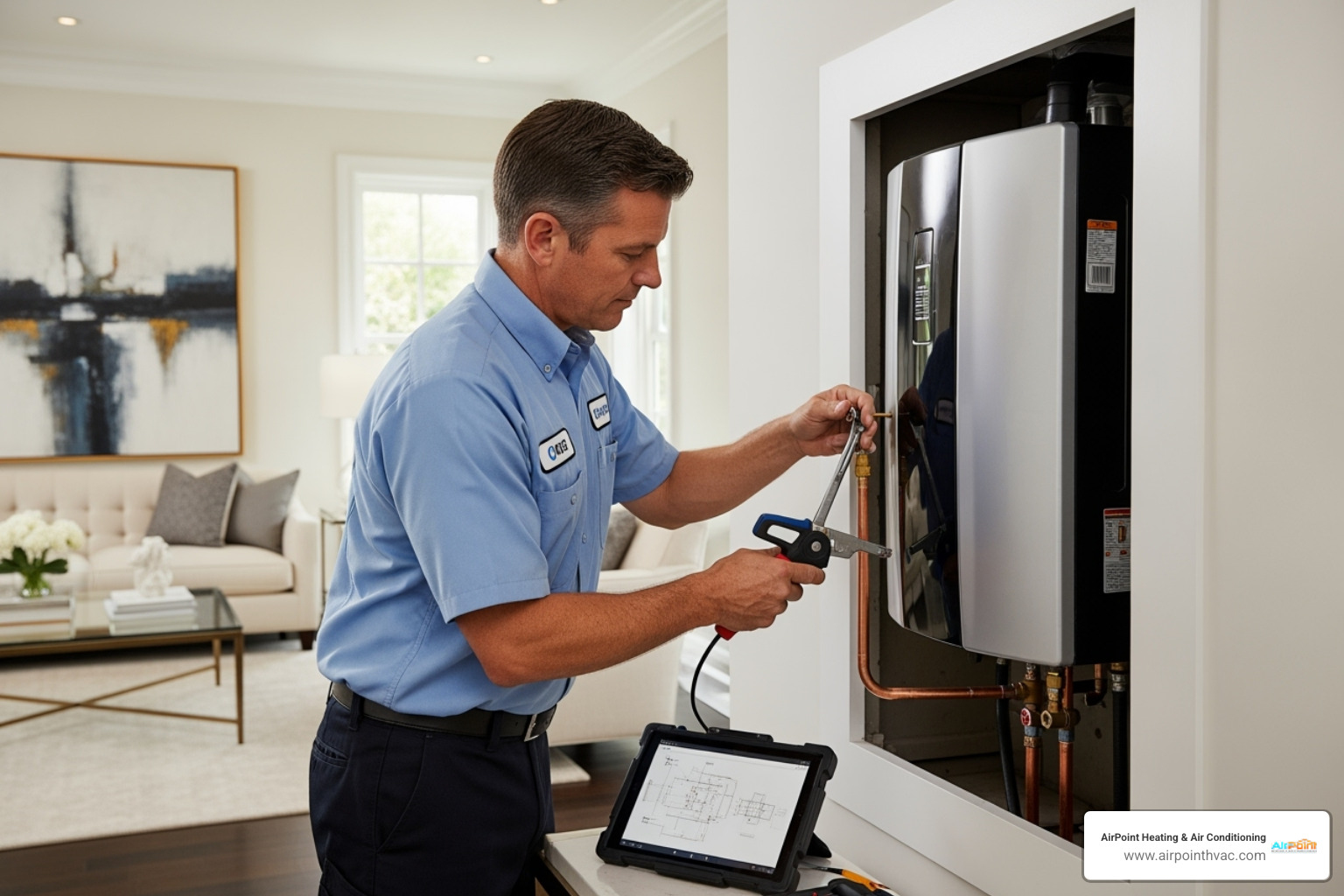
Beyond Basic: Custom Heating Solutions for Beverly Hills Luxury Homes

The Ultimate Guide to Heating Installation in Irvine: What You Need to Know

Huntington Harbour Heating Installation: Custom, Luxury & New Systems for Your Home
Customer Testimonials










